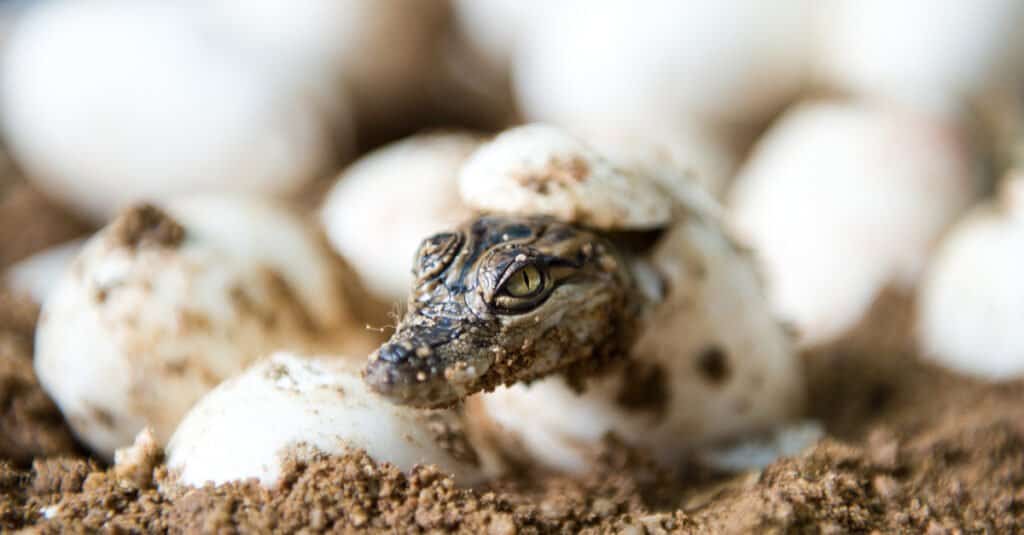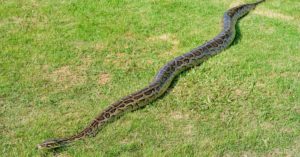
Alligators have 74 to 80 teeth.
©Nagel Photography/Shutterstock.com
Alligators are famous roadside attractions throughout the southeastern United States. These semi-aquatic reptiles are members of the Alligatoridae family within the Crocodilia order–the same order crocodiles, gharials, and caimans are categorized in. There are two extant species of alligator; the American alligator, and the Chinese alligator.
Alligators are smaller than the monstrous Nile crocodile. Though some American alligators have reached lengths of nearly 20 feet, most are closer to a maximum 14 feet. Chinese alligators are even smaller, usually around seven feet long.
They may look similar, but alligators and crocodiles have some pretty important differences–starting with their teeth. Here, we’ll find out all there is to know about alligator teeth, what they use them for, and how they grow replacement teeth. Then, we’ll learn about the special, one-of-a-kind tooth that baby alligators have, and just how dangerous these incredible creatures are to humans.
What Kind of Teeth Do Alligators Have?
Alligators have broad snouts, unlike crocodiles, which have relatively narrow jaws. Inside their mouths are two rows of teeth–one on the top and one on the bottom–that run all the way around their mouth like the letter ‘U’. Most of their 74-80 teeth are roughly the same size; with the exception of the fourth tooth from the front.
This tooth, which sits about where the canine would sit in a dog, is bigger than the rest. Its structure is a little different from the structure of the teeth in front of it, which are in turn distinct from the further back teeth. These distinctions make the alligator a heterodont–meaning it has more than one type of tooth, even though they all appear similar.
Alligator Smile

Alligators have an overbite; when they close their mouths, only their top teeth are visible
©iStock.com/zhnger
The easiest way to tell an alligator from a crocodile is by its smile. When crocodiles close their mouths, all of their teeth–top and bottom–show over their gums. But when an alligator closes its mouth, only the top teeth remain visible. These maxillary (top) teeth hang over the bottom jaw because alligators have a slight overbite.
But where do the bottom teeth go when alligators close their mouths? Well, alligators have special sockets in their maxillae (upper jaws) that are specially fitted for the bottom teeth. When they close their mouths, the bottom teeth slot nicely into the sockets.
So, if you can’t tell whether you’re looking at an alligator or a crocodile–just look at their smile. Remember, alligators have an overbite; crocodiles do not.
How Do Alligators Use Their Teeth?
Alligator teeth are not sharp, they’re actually fairly blunt and dull. They don’t use their teeth to rend chunks of flesh from large prey, and because of their massive jaw muscles, they’re unable to chew. Instead, alligators use their numerous teeth to clamp down on slippery prey like fish and birds.
Once an alligator has something in its mouth, there is no escape–unless the alligator decides to let go. This is where the blunted teeth come in. Rather than cutting, they grip, preventing the prey from escaping. Alligators mostly hunt small prey that they can swallow in one bite, but in order to swallow it–they have to catch it first.
Alligators are ambush predators. When they find something to eat, they strike–trapping the creature in their jaws. The bite force of an alligator is one of the strongest bite forces on the planet. Usually, they hunt prey they can swallow in one bite. But if they happen to grab something bigger, they’ll hold on with their jaws, then roll their entire body around in a death roll to dislodge enough meat to swallow.
Growing New Teeth
Alligators frequently lose or break teeth. These are almost immediately replaced by the growth of new teeth from the surrounding dental laminae. An alligator may grow hundreds of teeth in its lifetime, and it’s all thanks to a very special kind of cell located in the dental lamina.
Alligators regenerate teeth as quickly as humans regrow fingernails. They achieve this through the use of odontogenic stem cells in their jaws. These cells are instrumental in growing new teeth. It’s a good thing too; alligators live long lives, and if they couldn’t regrow lost teeth, they would have a very hard time feeding themselves.
Are Alligator Teeth Hollow?
When alligators grow new teeth, the new teeth erupt below the old teeth, slowly pushing them out. Because of this, alligator teeth have the appearance of being hollow. In this case though, hollow doesn’t mean fragile. Alligator teeth grow in one on top of another, but they’re still extremely tough.
Egg-Teeth

Baby alligators have a tiny egg tooth on the tip of their snout
©hxdbzxy/Shutterstock.com
Alligators have one additional tooth that disappears by the time they reach adulthood; the egg tooth. Like all reptiles, alligators begin life inside eggs. The eggshells are a lot tougher than chicken eggshells–they have to be to protect the baby alligators within.
As the infant alligators develop, they grow a tiny, sharp toothlike projection on the tip of their snout. This is the egg tooth. When the alligator is ready to hatch, it knocks the egg tooth against the inside of the eggshell. The shell cracks, and the baby alligator escapes its egg forever.
Do Alligators Bite People?
Because alligators and humans frequently share the same habitat, contact between the two is common. Small alligators would rather hide, or swim away, than confront a human, and will only bite if cornered or threatened. Large alligators however are big enough, and deadly enough, to attack and even kill humans, though instances of this are rare.
If you encounter an alligator in the wild, remember–it is illegal to feed any wild alligator. You should never approach an alligator either, no matter the size.
The photo featured at the top of this post is © iStock.com/unclegene
Thank you for reading! Have some feedback for us? Contact the AZ Animals editorial team.







